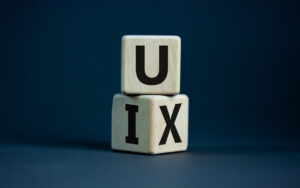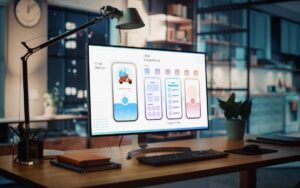With people interacting with technology more than ever, creating intuitive and seamless user experiences has taken precedence for businesses. Whether it’s a website, an app, or software, nothing performs without good UI and UX. Because of the ubiquity and demand of UX/UI today, it’s a rewarding career.
This article about UX/UI designer job description will help you understand the role of UX/UI designers, their job responsibilities, and what hiring companies expect of them. We will also explore the job outlook, top employers in the field, and how you can gain the right skills through online UX/UI training.
Who is a UI/UX Designer?
A UI/UX designer is a professional who combines user interface (UI) and user experience (UX) design when creating products and services. The point is to make them usable, enjoyable, and accessible to users.
UI design is all about creating and implementing the visual and interactive elements. This is the part that a user sees and uses to interact with a product or service. UX design is the process of planning and designing the interaction that a user has with a product or service. The goal is to cater to the user’s needs, goals, and pain points.
A UI/UX designer conducts user research, creates mockups, wireframes, and prototypes, and works closely with other designers and developers. According to a study by Forrester, a good UI can raise a website’s conversion rate by up to 200%, while a better UX design can raise the conversion rate by up to 400%.
Also Read: UI/UX Designer Salary: What Can You Expect in 2023?
What Does a UX/UI Designer Do?
A day in the life of a UX/UI designer is an exciting mix of creativity and problem-solving. Here’s a glimpse into their typical day:
- UX designers start by conducting user research, analyzing behavior, and identifying pain points. UI designers are more involved in visual trends, staying updated with design principles and industry standards.
- UX designers craft user personas to represent diverse user groups, while UI designers work on visual elements, like icons, buttons, and typography, adhering to branding guidelines.
- UX designers architect the information flow within a digital product, while UI designers focus on layout, color schemes, and visual hierarchy.
- UX designers create wireframes, outlining user flows, while UI designers start designing the visual elements. Both collaborate to build interactive prototypes.
- Together, they gather feedback from real users, iterating and refining the product based on their insights.
Throughout the day, they collaborate closely with cross-functional teams to ensure the user journey aligns with the product’s vision. Their end product is a captivating digital experience that meets user needs and is visually appealing at the same time.
Understanding UX/UI Designer Job Description
When you venture out to get a job in the UI/UX department, you are likely to meet different types of job descriptions. It can often leave you more confused. Here is a breakdown of why it matters to understand the job description and how it can help you in your career journey.
-
- Clarity of Expectations: With a clear UX/UI designer job description, you have a blueprint for what is expected of the candidate and what the company is working on. It should outline core responsibilities, qualifications, and expectations for the role
- Identify the Skills and Abilities: When you look at a good UX/UI designer job description, you should be able to pinpoint the specific skills and abilities required for the role. For example, if it mentions proficiency with prototyping tools like Sketch or Invision is essential, candidates can focus on honing these skills.
- Does it Align with Your Career Goals? A UX/UI job description should help you gauge whether the role matches your long-term aspirations and interests.
- Efficient Job Search: Ultimately, job descriptions act as filters, helping job seekers identify positions that match their qualifications and goals. This saves time and effort in the job search process.
- Preparation for Interviews: In-depth knowledge of the job description equips candidates to stand out in interviews. They can tailor their responses to showcase how their skills and experiences align with the role’s requirements.
In short, a good UX/UI designer job description can help a candidate make a stronger case for themself when applying for a role. Here is an example of a good JD for a UI/UX designer role.
UX/UI Designer Job Description Example
As a UI/UX Designer at [Company Name], you’ll be at the forefront of creating exceptional digital interactions. Your responsibilities will include:
User-Centric Design
Develop user-focused designs based on business requirements, user journeys, feedback, and usability findings.
Design Iteration
Quickly produce user flows, wireframes, prototypes, and mockups, adapting designs as needed.
Collaboration
Engage with cross-functional teams, including product, engineering, and business stakeholders.
Feedback Integration
Incorporate customer feedback, usage metrics, and usability insights into your design process.
Post-Launch Analysis
Analyze metrics post-launch to guide UX optimization efforts.
Tool Proficiency
Utilize prototyping tools such as Sketch, Invision, or equivalent for design and testing.
Qualifications
- Proven UI/UX design experience
- Proficiency in prototyping tools
- Exceptional communication, presentation, and collaboration skills
- A genuine passion for delivering outstanding user experiences
UX/UI Designer Skills Employers Look For
When hiring a UX/UI designer, the employer is looking for a specific set of skills. Here are some of the most commonly sought-after skills in a UI/UX designer.
- Problem-Solving Skills: UI/UX designers excel at solving complex design challenges and finding creative solutions to enhance user experiences.
- Conceptual Thinking: They should possess a conceptual mindset and a sharp visual awareness. They also need a willingness to learn specialized design programs.
- Coding and Design Knowledge: An understanding of coding and design principles is also essential. It helps in translating ideas into practical and functional digital experiences.
- Effective Communication: Strong communication skills are essential to collaborate with team members and clients. They need a collaborative mindset to perform well.
- Customer Empathy: UI/UX designers empathize with users. This skill can help them to grasp user needs and preferences to create user-centric designs.
- Attention to Detail: Excellent written communication skills and a keen eye for detail are critical skills. It can help them create precise and polished design solutions.
- Design and Spatial Skills: They can assess the usability of websites or applications. It helps them design aesthetics and spatial arrangement.
- User-Centric Approach: UI/UX designers apply a logical, step-by-step approach to ensure that designs are user-friendly and intuitive.
- Adaptability: It is a rapidly evolving field. An open, flexible, and adaptable mindset is needed to enable constant learning.
If you’re interested in pursuing a career in UI/UX design and want to develop these skills, consider enrolling in our UX/UI design program. This can help you kickstart your career in UI/UX.
UX/UI Designer Responsibilities
As a UI/UX designer, your tasks will be crucial in creating exceptional digital experiences. Here are the key responsibilities you’ll be expected to perform in this role.
Investigating User Experience Design Requirements
Dive deep into understanding the unique requirements of user experience design across the spectrum of digital products.
Developing UI/UX Design Strategy
Conceptualize and develop a comprehensive UI/UX design strategy that aligns seamlessly with the brand’s vision.
Crafting UX Design Solutions
Produce top-notch UX design solutions through various techniques, including wireframes, visual and graphic designs, flow diagrams, storyboards, site maps, and prototypes.
Designing UI Elements and Tools
Create visually appealing and user-friendly UI elements such as navigation menus, search boxes, tabs, widgets, and other digital assets.
UI Testing and Optimization
Rigorously test UI elements, including CTAs, banners, page layouts, designs, flows, and links, ensuring optimal user experiences.
Collaboration Across Teams
Collaborate closely with cross-functional teams – including marketing and internal and external designers – to deliver tailored digital experiences.
UX Research and Testing
Provide guidance and expertise in implementing UX research methodologies and testing activities, enabling in-depth analysis and prediction of user behavior.
Adhering to Style Standards
Maintain consistency by adhering to style standards related to typography and graphic design. This ensures a cohesive and brand-aligned user experience.
UX/UI Designer Job Description: Roles
UI/UX design encompasses a wide spectrum of specialized roles within the field, such as:
Visual Design
Responsible for the aesthetics, look, and feel of products, collaborating closely with interaction designers and copywriters to create visually pleasing and user-friendly designs.
Research and Usability
Focuses on user research, conducting interviews, observing user behavior, hosting focus groups, and analyzing data to provide valuable insights for the UI/UX team.
Coding (UX Engineering)
Bridges the gap between design and engineering, translating design concepts into functional products using coding languages like HTML, JS, and CSS.
UI/UX Writing
Specializes in crafting microcopy and user interface text, enhancing website navigability and overall user experience through carefully chosen words and messages.
UI/UX Designer Qualifications
Educational qualifications you typically find in a UX/UI designer job description include degrees in fields like:
- Computer science
- Digital design
- Digital marketing
- Graphic design
- Media technology
- Web design
These degrees provide a solid foundation in the skills and knowledge required for the role.
However, it’s worth noting that the UI/UX field is open to individuals with diverse backgrounds. Self-taught designers who have a flair for HTML and UX software can create successful careers even without formal degrees. It ultimately comes down to your portfolio. It should showcase practical skills, and real-world projects often outweigh formal qualifications.
Also Read: The UX/UI Design Process: Everything You Need to Know
UI/UX Designer Job Opportunities
Every sector now showcases digital products, be it service, education, manufacturing, etc. Where there is a digital product, there is the need for a UI/UX designer. As an aspiring UI/UX developer, you will find ample opportunities in various fields. When you begin your search, look for areas like:
- Education
- Finance
- Healthcare
- Manufacturing
- Public services
- Media
- Retail
- Telecommunications
There are also amazing opportunities in digital media, software, or web development agencies working on diverse projects.
The future outlook for UX designers is exceptionally favorable. With the increasing importance of user-centered design, businesses are recognizing the value of skilled UX professionals. According to the U.S. Bureau of Labor Statistics, a projected growth rate of 16% from 2022 to 2032 is expected for UI/UX developers. This growth rate is much higher than the average for all occupations.
UI/UX Designer Salary
Owing to the growing demand for UI/UX designers, they enjoy competitive salaries. Companies offer attractive packages to exceptionally talented designers. According to the U.S. Bureau of Labor Statistics (BLS), the median annual wage for web developers, which includes UI/UX designers, was $83,240 in May 2022.
According to Glassdoor, the average salary of a UI/UX designer in the US is around $87,768 per year. The total pay range can be from around $71K – $124K/yr.
The US BLS also predicts that over the decade, nearly 19,000 job openings for web developers and digital designers will become available each year.
Job growth and increasing opportunities in UI/UX design make it a lucrative career path for those with the right skills and experience.
Launch Your UX/UI Journey Today
The world of UI/UX design is nothing short of exciting for those who have a passion for creating exceptional digital experiences. Whether you’re starting your career, looking to upskill, or aiming to dive deep into UI/UX, the opportunities are vast.
If you’re ready to embark on this transformative path, consider enrolling in our UX/UI Bootcamp. Equip yourself with the knowledge and practical expertise of industry leaders. Learn the essential skills, get hands-on experience, and explore the networking opportunities you need to thrive in the competitive UI/UX landscape.
Don’t miss the chance to find your space in the UI/UX world. Sign up and take the first step toward your dream career today!






